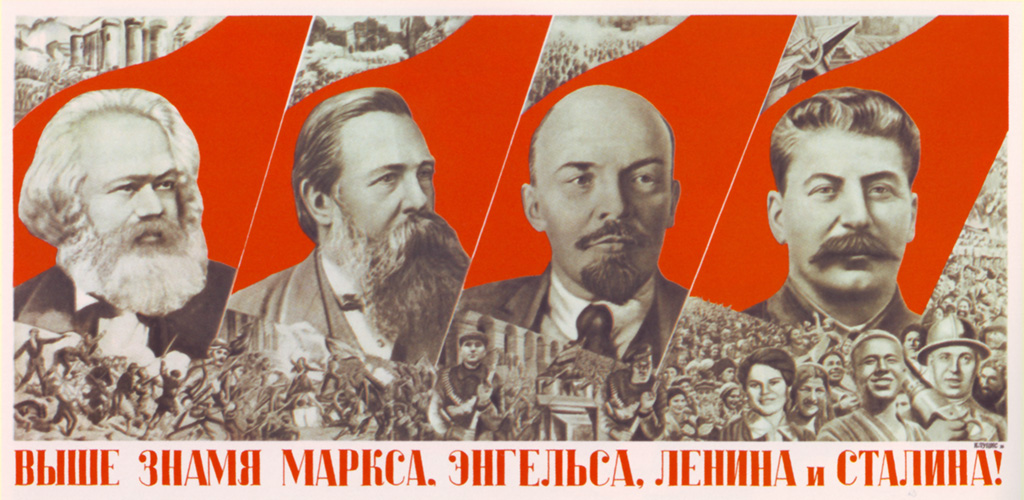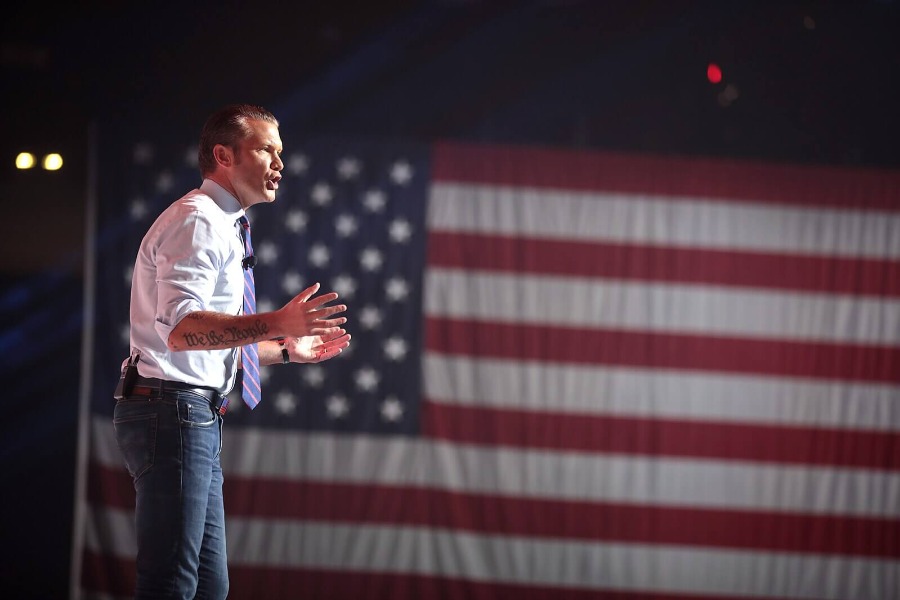Addressing Russian Influence: What Can We Learn From U.S. Cold War Counter-Propaganda Efforts?
Microsoft and Google have joined Facebook in revealing that Russia may have purchased ads in an effort to manipulate the 2016 U.S. presidential election. Reactions to this news have been a mix of bewilderment and alarm—but perhaps we should not be so surprised. The fabricated news stories and click-bait headlines that dominated social media throughout the 2016 campaign are not a new tactic for the Russians. They are simply the latest iteration of a practice Moscow has used for nearly a century.

Published by The Lawfare Institute
in Cooperation With

Microsoft and Google have joined Facebook in revealing that Russia may have purchased ads in an effort to manipulate the 2016 U.S. presidential election. Reactions to this news have been a mix of bewilderment and alarm—but perhaps we should not be so surprised. The fabricated news stories and click-bait headlines that dominated social media throughout the 2016 campaign are not a new tactic for the Russians. They are simply the latest iteration of a practice Moscow has used for nearly a century.
This type of operation is known in the intelligence community as “disinformation,” an Anglicization of the Russian term “dezinformatsiya.” Disinformation has taken many forms across the decades, from funding communist newspapers to orchestrating the publication of news stories based on forged documents. During the Cold War these tactics were at the forefront of the Soviet Union’s strategy to discredit and undermine the United States. In light of this history, it is perhaps useful to look at how the United States countered Soviet tactics and consider whether any U.S. countermeasures drawn from the past can be adapted to address the situation today.
The Soviets’ Historical Use of Propaganda
Early Soviet disinformation focused on softening Josef Stalin’s image in Europe and easing concerns that the USSR had expansionist ambitions. In the 1930s, Moscow orchestrated the dramatic escape of “defectors”—diplomats such as Grigory Besedovsky, who very publicly “escaped” the Soviet embassy in Paris, and Sergei Dmitrievsky who did the same in Stockholm. Both initially spoke out against the USSR and later, after gaining credibility, began disseminating disinformation about the regime, portraying Stalin as tough but honest, pro-Western and strictly Russia-oriented.
After World War II, the Soviets shifted their focus to the United States. Two years after the surrender of Nazi Germany, in 1947, Soviet leadership created the Committee of Information to run undercover operations to influence public opinion. In the 1950s, a specialized intelligence unit was established specifically to disseminate disinformation. In the 1970s, as disinformation became a larger part of the Soviet strategy, the unit was upgraded to a full service and placed under the command of a KGB general.
The Soviets created several avenues for disseminating disinformation. Moscow covertly funded communist newspapers and radio stations around the world, particularly in Africa and Latin America, where they especially hoped to exert influence. They also funded communist parties in Western countries, and established fronts—such as the World Peace Council, World Federation of Free Trade Unions, and the World Federation of Democratic Youth—to spread communist ideology.
One of the most popular methods of disseminating disinformation targeted legitimate news outlets. By anonymously sending forged documents—such as embassy communications or military memoranda—to credible publications, the Soviets attempted to create well-timed fake news stories that the public accepted as true. Once the stories caught on, they were reprinted extensively in Soviet-controlled papers in the hopes that the story would be picked up by more mainstream sources—and would gain credibility in the process.
Disinformation often highlighted unattractive aspects of American culture, exaggerating real problems and imagining non-existent ones. A particular object of disinformation campaigns was the very real systemic racism and discrimination in the United States. When the truth had the potential to be damaging enough on its own, the Soviets simply aimed to direct attention to the story. The arrest and trial of the African-American communist academic Angela Davis, for example, was widely publicized by Soviet outlets, particularly in Africa. Davis was accused of providing a handgun to militants, who then used the weapon in a courtroom shooting. The propaganda pieces about her trial described the proceedings as racially and ideologically driven, and they predicted an unjust outcome. Soviet efforts, at least in this instance, were ultimately undermined when Davis was acquitted by an all-white jury.
Stories from the emerging civil rights movement were distorted to create an exaggerated picture of the racial divide in the United States. Many Soviet citizens believed that lynchings were commonplace and legal, that broad swaths of American society accepted the KKK, and that most schools were segregated. More often, however, disinformation stories were simply pure fabrications. Following President Jimmy Carter’s boycott of the Moscow Summer Olympics in 1980, the KGB forged letters from the Ku Klux Klan that threatened athletes from African countries and mailed them from Washington, D.C., to the countries’ Olympic committees. Although none of the countries succumbed to this intimidation, the attorney general and FBI Director were forced to deny U.S. involvement and point the finger at Moscow.
Though “fake news” was a popular tool during the Cold War, it was much more effective in developing countries where journalistic standards were lower. In Latin America and Africa, forged documents tended not to be investigated thoroughly prior to publication, and, as a result, Soviet disinformation campaigns successfully soured public opinion of the United States. In the West, success was more elusive. Journalists were more careful; they were more likely to follow up on suspicious allegations and less likely to publish a story with a single, anonymous source of evidence.
A better-known disinformation campaign, the ominously named Operation INFEKTION, sought to exploit international fears of U.S. military expansion by sowing the narrative that AIDS had been created as the result of American biological weapons experimentation. The story, based on an anonymous letter from an “American scientist,” was initially published in a communist Indian newspaper, but at the time it was largely ignored. It was revived three years later, however—this time, in an East German paper and with the additional backing of a pseudoscientific report published in East Berlin. The story spread quickly, primarily through publication in Soviet and other communist or leftist papers around the globe, and entered the public discourse to the point that U.S. officials were forced to repeatedly address and refute the story. It only disappeared from headlines after the United States threatened to cut off scientific cooperation with the USSR in the field of AIDS research.
Other forgeries also tried to paint an unflattering picture of the United States, depicting a government eager to use assassination, coups, and election manipulation to achieve its ideological goals. A forged telegram attempted to link the killing of Afghan leader Hafizullah Amin to a CIA plot. A separate forged letter appeared to show American support for the conservatives in the 1981 Greek elections and plans for a coup if Socialist leader Andreas Papandreou won. Fake documents in 1983 seemed to show plans to overthrow the Ghanaian regime. A forged Presidential memorandum to the Departments of State and Defense and the CIA appeared to order those agencies to establish a U.S. military force called the “Permanent Peace Forces” that would be used to intervene in Latin America—thus inflaming nationalist and anti-American sentiment in the region.
The disinformation campaigns also attempted to portray the United States as an untrustworthy ally, though these campaigns were largely unsuccessful. A forged letter published in a left wing Belgian newspaper, for example, appeared to show retired NATO Commander Alexander Haig and NATO Secretary General Joseph Luns discussing a nuclear first strike and planning a sensitive operation to “jolt the faint hearted in Europe.” A separate forged letter from President Ronald Reagan to Spanish King Juan Carlos appeared to show the United States putting pressure on Spain to join NATO, while a forged speech purportedly for U.N. Ambassador Jeanne Kirkpatrick appeared to show U.S. support for the balkanization of India.
These campaigns also, somewhat ironically, attempted to demonstrate that the United States was engaging in disinformation campaigns of its own. Fake telegrams from the American Embassy in Rome purportedly showed plans to blame the 1981 attempted assassination of Pope John Paul II on the Soviets. Another attempt used a forged letter from a United States Information Agency (USIA) official to a senator, in which the official suggested the use of false statements and exaggerations about the Chernobyl disaster to damage perception of the Soviets, although—under this Soviet narrative—the plot was uncovered before the letter could circulate.
If all of this sounds eerily familiar, it should: The goals and tactics of Putin’s Russia are not far removed from the goals of Soviet era propagandists. Putin’s Moscow has continued the strategy of using disinformation to take advantage of and further sow civil discord in the United States, to undercut the United States directly and to undermine U.S. foreign relations.
The recent revelations from Silicon Valley giants Facebook, Google, and Microsoft—revelations that Russia likely spent hundreds of thousands of dollars on politically targeted advertising that spread disinformation—illustrate how Moscow is pursuing long-standing foreign policy goals while adapting to changing technology. The political ads appeared to address both sides of the U.S. political divide, reaching millions of Americans. The goal of these ads appears to be the widening of domestic divisions and amplification of existing fears. Some Facebook ads, for example, supported the Black Lives Matter movement, while others aimed to paint the organization as a danger to society. Some ads appeared to highlight support for then-candidate Hillary Clinton, while others attempted to alarm potential voters by showing her popularity with Muslim women. In a number of cases, the ads were targeted directly at key demographics in Wisconsin and Michigan.
Russia still uses its own overt propaganda machine to spread disinformation, particularly through the television station Russia Today and the news agency Sputnik. These outlets disseminate misleading and fabricated information about the United States and NATO members, often relating to those actors’ foreign policy objectives and military operations. Sputnik and Russia Today, for example, reported on a fire at a NATO base in Izmir, Turkey, alleging that the fire was the result of intentional sabotage after the failed Turkish coup. Although there had been a fire, it was blazing some distance away in a nearby forest and did not appear to have been the result of arson. Stories like these are often not intended to influence American voters, but instead to affect Russian citizens and sympathetic foreign nationals by fostering the perception of the United States as a war mongering, expansionist nation.
U.S. Counter-Propaganda Efforts
During the Cold War, the United States utilized a range of strategies to push back against Soviet active measures. These can be categorized in three groups: First, the United States centralized its response and coordinated a strategy in order to utilize the power of its example; second, it responded directly to Soviet efforts, cultivating thought leaders around the world and spreading American narratives globally over a variety of mediums; and third, the United States acted to inform the public and embarrass Soviet officials by calling out Soviet propaganda while strengthening allies, media outlets and public officials in a position to prevent the spread communist propaganda.
Efforts like the Marshall Plan, the space race, the civil rights movement, and international development efforts all can be viewed as attempts to respond through the power of example. The United States also responded directly to Soviet efforts, empowering the CIA to cultivate and develop foreign thought leaders while creating the United States Information Agency (USIA) and authorizing it to push an American narrative to the world. Later, after these efforts dwindled, the Reagan administration would create the Active Measures Working Group (AMWG)—perhaps the most successful counter-propaganda effort of the entire Cold War.
Sensing that it was losing the battle for the European intelligentsia, in 1953, President Eisenhower established the United States Information Agency (USIA), which became the chosen instrument for ideological operations during the Cold War. At its height, the USIA had the most extensive overseas presence of any Washington agency. USIA’s activities included publishing magazines, pamphlets, leaflets and establishing a global library network. In the Soviet Union, the U.S. Embassy distributed copies of magazines and books to officials and other prominent people. One such official was none other than a young party-secretary named Mikhail Gorbachev.
Perhaps most importantly, USIA produced Voice of America—a network broadcast heard by over 100 million people and in over forty languages during the Cold War. It is hard to judge how effective programs like Voice of America were in changing public opinion, but Soviet officials disliked them enough to invest significant resources into building a vast network of jammers that emitted noise on frequencies used by Western broadcasters. The jamming program was massive, and its total power was estimated to be three times that of all Western radios combined. In the face of such resistance, however, Western programmers simply targeted smaller cities and rural areas where jammers were less concentrated. Through underground networks, Soviet dissidents made copies of broadcasts, distributing them throughout the country.
USIA programs were only one part of official efforts to influence the rest of the world, however. Other federal bureaucracies—in particular the Department of Defense and the CIA—matched, and often surpassed, the USIA’s operations.
In Europe, military intelligence planners stockpiled large polyethylene balloons full of propaganda notes. The balloons would then rise 30,000-40,000 feet, follow the prevailing wind, and break open at predetermined coordinates, scattering leaflets across the land below. This operation lasted from October 1951 until November 1956, and for its duration, the skies of Central Europe were littered with more than 350,000 balloons carrying over 300,000,000 leaflets, posters, books and other printed matter.
Beginning in 1950, the CIA covertly established and funded the Congress for Cultural Freedom. At its peak, the Congress had offices in 35 countries, employed dozens of personnel, published over twenty prestige magazines, held art exhibitions, owned a news and features service, organized high-profile international conferences, and rewarded musicians and artists with prizes and public performances. Its mission was to nudge the intelligentsia of Western Europe away from its lingering fascination with Marxism and communism towards a view more accommodating of the American way.
The United States engaged in less idealistic measures as well. The Operations Coordinating Board, an “ideological warfare” planning team within the National Security Council, was tasked with creating integrated country plans to manage communism. These plans generally followed the standard lines of containment: for example, plotting and executing an intervention in Philippine elections to ensure a pro-Western result and facilitating anti-communist activity by trade unions in order to destabilize the government of Arbenz Guzman in Guatemala. The CIA also used U.S. corporations to funnel money to non-communist political parties and trade unions. Private publications, such as The International Herald-Tribune received money to reprint pro-U.S. news.
The Active Measures Working Group
U.S. attempts to counter Soviet disinformation eventually fell out of favor in Washington and had virtually disappeared by the late 1970s. Yet in 1981, with the election of Ronald Reagan, the United States re-energized its efforts, creating the Active Measures Working Group (AMWG). AMWG was an interagency committee chaired by the Department of State and included representatives of the CIA, USIA, the U.S. Arms Control and Disarmament Agency, and the Departments of Defense and Justice. Operating under its methodology of “Report-Analyze-Publicize” (RAP), AMWG officials monitored Soviet disinformation campaigns, issued regularly updated reports, talked to Western press, personally called editors of newspapers that ran Soviet-sponsored disinformation stories, and occasionally confronted Soviet officials directly about particular active measures.
By limiting the scope of its activities to countering Soviet influence operations that could be exposed in a compelling way, the AMWG was able to significantly undermine the effectiveness of Soviet disinformation campaigns. The group published its first report, “State Department Special Report 88” in October 1981. The document was simple, containing a four-page overview of Soviet disinformation techniques and themes. Yet over 14,000 copies of the report were distributed to news organizations, federal agencies and allies. Six years later, the document would find its hands into none other than Mikhail Gorbachev, who waved a copy at then-Secretary of State George Shultz, complaining that the information was damaging the Soviet Union’s reputation. Simply exposing Soviet acts of disinformation proved an extremely powerful tool.
Lessons from U.S. Counter-Propaganda Efforts
The current Russian strategy of active measures, of which disinformation is one part, appears largely the same as that utilized during the Soviet period. However, significant changes in the media landscape have made those active measures more effective in today’s United States. From the late 1940s until the fall of the Berlin Wall, Soviet agents had difficulty utilizing active measures against Western countries; well-trained journalists and editors were generally suspicious of too-good-to-be-true claims and they thoroughly vetted stories before publication. Those outlets where the Soviets found success in placing disinformation tended to be outlets that were discredited by their very nature: party magazines, tabloids, or well-known pro-communist publications with small readerships. Writing in 1983 for the U.S. Army War College’s journal, Ambassador Dennis Kux, former director of the Active Measures Working Group, noted:
Disinformation appears to fare poorly in Western Democracies with their free press. With a few exceptions, disinformation has largely surfaced either in sensationalist or pro-communist journals, where it has little impact on public opinion. Responsible journalists and journals check out suspicious sounding allegations or anonymous documents. They do not generally publish stories lacking evidence and sourcing.
Today, the media landscape is vastly different: No longer do major media outlets dominate limited information streams. Reflecting the broader disintermediation of American society, technology has given rise to many more media organizations and information platforms, not all of which share the same editorial standards or capacity as top publications. Moreover, websites can be created cheaply and easily, and each one carries with it the potential to reach vast audiences, based not on long-term credibility and accuracy, but instead on displaying the right headline and click-bait story at the right time. Whereas Soviet agents would plant disinformation in Indian or Nigerian media and wait for it to bubble up to major outlets, Russian propagandists today have to worry less about getting disinformation past pesky editors and can instead inject it directly into the mainstream of democratic discourse.
Even so, there may be lessons that the United States can learn from its Cold War competition with the Soviets, particularly from the later success of the AMWG.
To do so, it is important to distinguish between two related, but analytically distinct, Russian active measure tactics. The first involves the hacking of governmental and private computer systems and selectively leaking sensitive information in order to create a desired misperception of reality. A second tactic consists of deliberate distortion, outright manipulation and active lying in order to create a false understanding of the world.
We have noted throughout this piece that the strategy associated with active measures and disinformation is substantially the same as before, but that because of changes in media technology and Russian tactics, it now seems to be more successful in the United States. We posit that this is because until very recently, free speech had a set of natural regulators. Producing a widely read newspaper or a well-watched television show was capital intensive. Moreover, top publications with large readerships had sophisticated editors who viewed it as their ethical responsibility to separate fact from fiction. This ethical responsibility was supported further by a professional duty to ensure that the paper maintained its credibility with its audience. After all, that long-term credibility was a business asset. Today, that appears to no longer be true, especially as Facebook impression algorithms distort economic incentives.
The question then is how to replicate those regulators—the guardians of the marketplace of ideas—in a rapidly disintermediating society.
The first step may simply be to create a new AMWG-like working group tasked with tackling Russian disinformation directly, publicly and deliberately. This group could coordinate policy and platform solutions with major technology companies, review and propose legislative solutions, and empower, strengthen and educate the press, diplomatic officials and the public at large in order to combat Russian active measures.
Transparency is key. The AMWG found success when it took the time to publicize what Soviet propagandists were doing and why. According to Dennis Kux, “[t]he best means of rendering the ground less fertile is to ensure that people . . . are fully aware of attempts to deceive them.” An interagency group that focuses on credibly highlighting Russian activity could potentially replicate that success. At the moment, some non-governmental groups have taken on this project. For example, the German Marshall Fund recently launched “Hamilton 68.” a project led by Clint Watts, J.M. Berger, Andrew Weisburd and Jonathon Morgan that seeks to expose the effects of Russian online influence networks in real time and to inform the public of themes and content being promoted to Americans by foreign powers. A new AMWG could launch similar efforts or help insure that non-governmental efforts are adequately funded.
This work may seem duplicative at a moment when both special counsel and congressional committees are actively investigating Russian activity. But that interest will not prove sustainable over the long term: Mueller will end his investigation and Congress will move on at some point. High-profile institutional actors cannot sustain intense focus on a single issue forever. Russia, by contrast, will remain a persistent threat. Reestablishing a lean interagency committee to coordinate counter-narratives and responses to Russian active measures has value. That work, in fact, could not be more important.
Throughout its tenure, the original AMWG repeatedly noted that Russian propaganda rarely had a substantial impact inside the United States because credible media outlets usually weeded out fake stories and false headlines, preempting them from reaching large audiences. Today, the flow of information no longer appears to permit the United States such refuge. As part of its work, then, this new AMWG should coordinate with technology companies to find solutions that effectively disrupt Russian activities.
But tech companies need not wait for the creation of such a group. Leading social media platforms and major news outlets should start by providing a forthright account to the American people about what has happened and what they see happening today. They could also begin by implementing the most apparent solutions, two of which we outline below.
One solution is that journalists should adopt a norm against publishing hacked material until they are able to fully contextualize and verify it. This was precisely the approach that major news outlets in France took in early 2017 when, just a few hours before the end of the French presidential campaign, thousands of internal documents attributed to Emmanuel Macron’s campaign were published on the internet. Le Monde, in explaining its decision not to publish the leaked material, noted “these files were published 48 hours before the vote, with the clear goal of harming the validity of the ballot.” American outlets should adopt a similar norm. Many leaks have not been used to inform public discussion, but are instead a form of weaponized organization doxxing. And the New York Times and Washington Post have been more than content at times to parrot Wikileaks’ content without reflection in a race to publish.
Skeptics will assert that this will not solve the problem. Even if major U.S. outlets choose not to publish hacked material, foreign outlets, with no allegiance to the security or integrity of the United States, may choose to publish them online. Once on the internet and in English, they can easily ricochet around the internet with abandon. And of course, blogs, social media pages and other non-traditional media can easily pick up stories neglected by major outlets. Many of these concerns have merit.
Yet even so, there is reason to believe that a strategy of self-policing by major outlets could depress the success of Russian active measures. Most Americans continue to receive the majority of their news from established news outlets. According to Pew, only four in ten Americans regularly get their news online. Further, of those that do consume news online, roughly twice as many people receive their news from major news organizations than from social media. In this way, major media outlets can and should still play a regulating effect.
Online platforms also have a role to play in regulation. Already, some are stepping up. For example, Google has reconfigured search algorithms in an attempt to prevent conspiracy sites from populating search functions. Similarly, YouTube determined that “flagged videos that contain controversial ... content will be put in a limited state where they cannot be suggested to other users, recommended, monetized, or given comments or likes.” And Facebook itself has taken steps to tamp down the amount of disinformation on its platform, first by allowing users to flag purportedly fake news and second by providing users with additional information about publishers and related articles with a new “I” button on news feed links.
Paradoxically, these outlets should no longer be paralyzed by concerns of censorship. Free speech has always relied on credible regulators to inform the public and prevent the marketplace of ideas from collapsing into a cacophony of chaos, misinformation, and manipulation. Today, those regulators are no longer experienced editors or producers but must instead be the platform managers and users of online social media. In this way, we may even view this type of free speech regulation as more democratized.
Conclusion
The potential solutions we outline above are likely only the start of a conversation regarding what is required to push back against Russian active measures. Throughout the struggle for supremacy during the Cold War, the United States actively battled Soviet active measures and disinformation campaigns designed to discredit the United States abroad and undermine social cohesion at home. In recent years, Russia has renewed that fight, and while many factors have changed—some of which favor Russian efforts more than American responses—there is still a great deal that the United States can learn, both positive and negative, from its experience. The fight then was iterative and often experimental, and that dynamism and flexibility will likely be necessary today.







